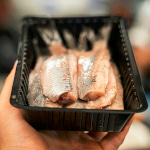Herring Day in Sweden Date in the current year: June 6, 2025
 Herring Day (Sillens Dag) is celebrated in Sweden on June 6, coinciding with Swedish National Day. However, it is not quite a coincidence; after all, when would it be better to celebrate one of Sweden’s signature foods than on the country’s national day?
Herring Day (Sillens Dag) is celebrated in Sweden on June 6, coinciding with Swedish National Day. However, it is not quite a coincidence; after all, when would it be better to celebrate one of Sweden’s signature foods than on the country’s national day?Herring is a general term for a number of forage fish species from the family Clupeidae, primarily the Atlantic herring and the Pacific herring. Herring has historically played an important economic and social role, and has been a staple food source in many regions since at least 3000 BC.
Herring is valued as a food item due to its high content of omega-3 fatty acids, B vitamins, vitamin D and phosphorus, as well as its versatility: it can be eaten raw, salted, fermented, pickled, dried, smoked, pan-fried, and cooked in other ways. Herring dishes are common in Baltic, British, Canadian, German, Dutch, Nordic, Polish, and some other cuisines.
Herring is the key ingredient in several iconic dishes of Swedish cuisine. Probably the most common Swedish herring dish is pickled herring (inlagd sill). It is prepared by curing the herring in salt to extract water and then brining it in a solution of salt, vinegar, and spices. Pickled herring is consumed in Sweden all the year round, but especially during holidays such as Easter, Midsummer, and Christmas. It is usually served with potatoes, sour cream, dark rye bread, or crisp bread.
Another popular herring dish is herring salad (sillsallad) consisting of diced salted herring fillets, pickled beets, potatoes, onions, and sometimes apples, and dressed with mayonnaise and whipped cream. S.O.S. is a traditional Swedish appetizer that consists of butter, cheese and herring. Its name is an acronym for the ingredients (smör, ost, sill) and a reference to the Morse code distress signal SOS. The appetizer usually accompanies akvavit, a flavored distilled spirit popular in Nordic countries.
Arguably the most well-known (and the most polarizing) Swedish herring dish is surströmming. It is lightly salted, fermented Baltic sea herring that has a somewhat acidic taste and a very strong smell that has been described as one of the world’s most putrid food smells. Because of its smell, surströmming is often eaten outdoors. It is typically served with boiled potatoes, finely diced red onion, Swedish flatbread (tunnbröd), and various condiments.
Given the culinary and cultural importance of herring in Sweden, it is not surprising that there is a holiday dedicated to it. The celebration of Herring Day was launched in 2008 in Klädesholmen, a village and fishing community situated on the eponymous island in Tjörn Municipality. The main goals of the holiday are to honor the herring and to support the Swedish Sea Rescue Society (Sjöräddningssällskapet) by raising funds through charitable events and activities.
Herring Day events and activities in Klädesholmen include a market with vendors selling everything from herring and other foods to handcrafted items, activities for children (drawing, face painting, etc.), demonstrations by the Swedish Sea Rescue Society, cooking workshops, rowing, entertainment on stage, a fish auction, and more. Attendees can also visit the local Herring Museum, join a guided tour of the village, and buy a herring tasting plate. All proceeds from the tasting plates are donated to the Sea Rescue Society.
- Category
- Unofficial Holidays
- Country
- Sweden
- Tags
- Herring Day in Sweden, Sillens Dag, unofficial holidays, food days, holidays in Sweden